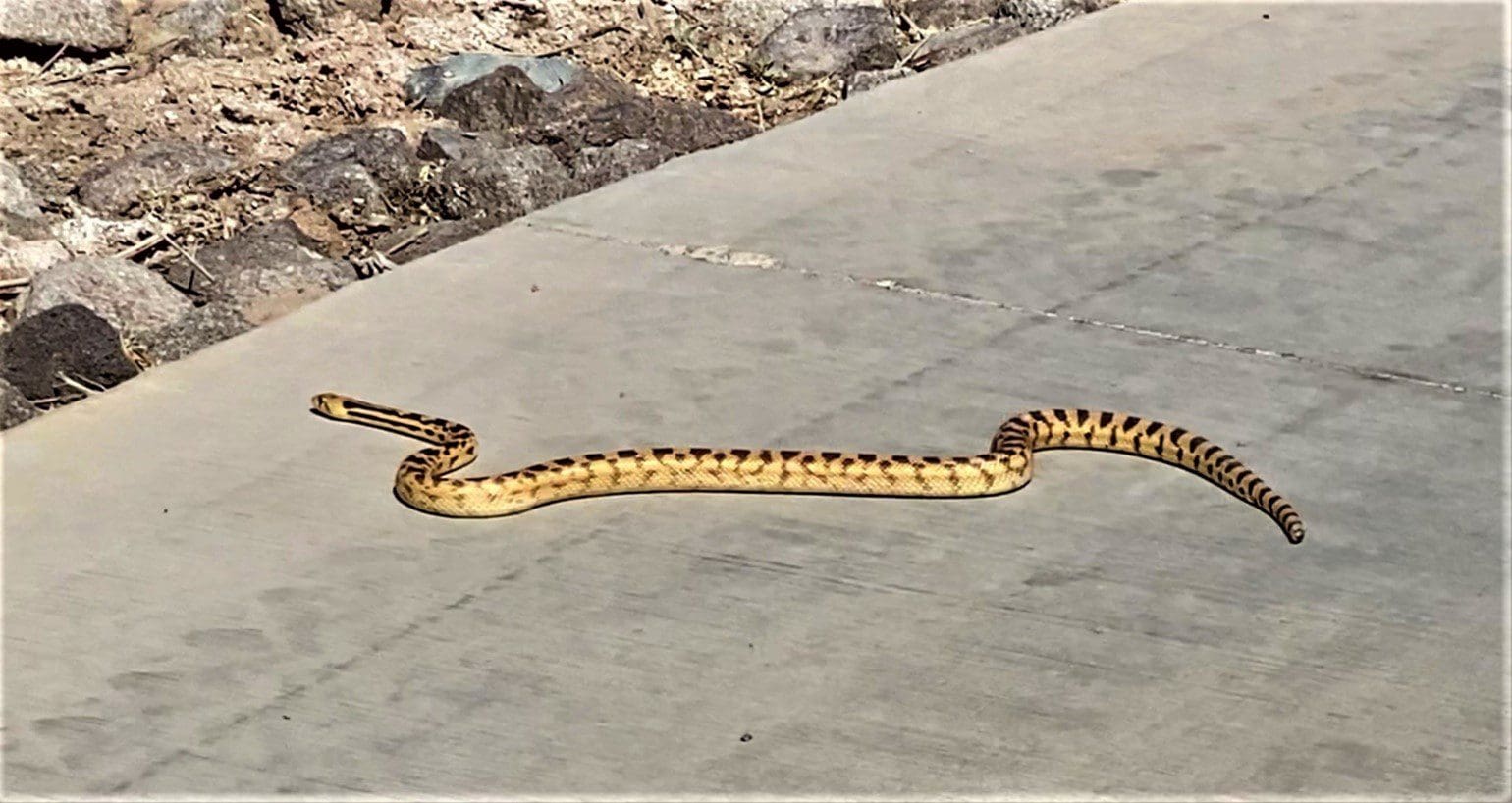The Gopher Snake

MY GOODNESS! THAT’S ONE BIG SNAKE!
Wow! This large snake is like the “gift that keeps on giving!” Gopher snakes are one of the longest snakes in the Mojave Desert, often reaching more than six feet, though three to five feet long is more common.
Gopher snakes belong to the biggest snake family, the Colubridae, with 249 species native to every continent except Antarctica. Gopher snakes range widely across most of North America, as far north as southern Canada and south into northern Mexico. They can be found in almost every habitat type below 8,000 feet in all four North American deserts (Great Basin, Mojave, Sonoran, and Chihuahuan).
Perhaps because of this wide distribution, these handsome golden snakes with their striking dorsal pattern of black “saddles” are called by several different common names, including the Henry snake, the gopher snake, the bullsnake, and the pine snake. Interestingly, the gopher snake’s Latin names really do describe its appearance and its behavior. Pituophis means “phlegm serpent,” a pretty good description of the snake’s loud hiss when threatened. The species name, catenifer, means “chain-bearing” and refers to the characteristic dorsal color pattern.
Gopher snakes are often mistaken for rattlesnakes because of their behavior when a predator threatens. A defensive gopher snake flattens its normally narrow head, coils into a characteristic “rattlesnake” striking pose, hisses fiercely, and even vibrates its tail. Of course, it has no rattle, but often the end of its tail shaking in surrounding dry debris or gravel actually does make a “rattling” sound. If pressed into striking, gopher snakes will often strike with their mouths closed, “punching” their foes with their blunt noses to drive them away.
These active hunters may be seen at any time of day. They prefer to feed on small mammals, but also take lizards, smaller snakes, birds, and eggs. They are constrictors, killing their prey by wrapping coils of their bodies around it and squeezing it tightly, then swallowing their meal whole, usually headfirst! Because of their preference for small mammals as prey, they are highly valued by ranchers and farmers for the control of “nuisance” mammals like rats, mice, and gophers.
Tame gopher snakes can make exceptional teaching ambassadors for nature centers, zoos, and museums. One of our Park Ambassadors, Cali, is a gopher snake. Years ago, I had two, Nosy and Blondie, when I worked at the Barrick Museum. They mostly worked in the “Out-to-the-Schools” program for elementary and middle school students, but on one memorable occasion, Blondie had thirty minutes of TV fame!
Sheilagh Brooks, an anthropology professor associated with the museum, was invited to provide a 30-minute presentation about the collections on live local television. She decided I would bring one of the school ambassador snakes (Blondie) to represent the natural history side of the museum, and she would bring some Native American artifacts to represent the archaeological side.
At the studio, I took Blondie out of her travel bag, and sat down in a chair next to Sheilagh. Blondie did “her stuff” first. She sat calmly in my lap, curiously sticking out her tongue to sample the strange smells around her, while I pointed out her characteristics for the camera. By the time I finished, however, the studio lights were beginning to feel pretty warm, and Blondie wanted some shade.
By the time Sheilagh started her presentation, Blondie had started to wriggle. The warmer she got, the more active she became. By the end of our 30 minutes, I felt as if I had a very active firehose in hand. Sheilagh, who really wasn’t a “snake person,” was struggling to keep her eyes off poor Blondie, who for her part was trying her best to climb out of my arms and into Sheilagh’s lap! Lesson learned: those studio lights are hot! Heat makes even a quiet snake very active! That 30 minutes felt like forever!
When hiking Clark County Wetlands Park spring to fall, keep an eye out for our resident gopher snakes. They are very easy to see crossing a concrete trail, like the snake in our photo. You will have to look harder to find them off the trail, where their coloration blends into the background and makes them harder to see. By the way, take a good look at our photo model’s tail – the pointed tip is missing, probably from a narrow escape sometime in the past!
– By Chris Leavitt, President; photo by Jon Drake.
Please enjoy these YouTube videos!
Great Basin Gopher Snake (pituopis catenifer deserticola) Ally Smith (2:37)
Nevada Gopher Snake Friends of Nevada Wilderness (1:36)
Great Basin Gopher Snake (Pituopis catenifer deserticola) DEFENSIVE BEHAVIOR MOJAVE OFF-GRID DESERT BUG-OUT (2:38)
A special note: Friends does not endorse or have any affiliation with advertising playing on any of these videos.
